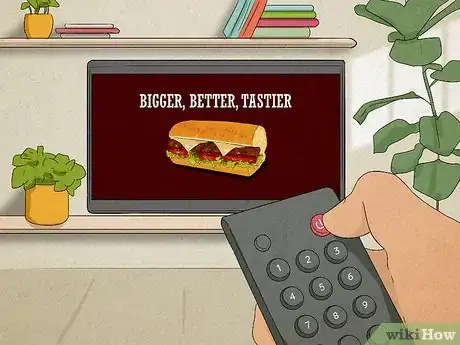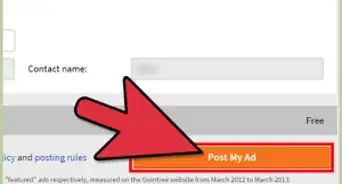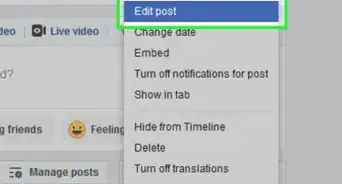This article was co-authored by Minoti Mehta. Minoti Mehta is the Founder of Vermilion Weddings & Events, an event and wedding planning business based in San Francisco, California. Minoti grew up in the event and wedding planning space and has over five years of event planning experience. She has been invited to participate as a Delegate at five exclusive Event Planner Conferences including Destination Wedding Planners Congress and Planners Xtraordinaire and has become known as one of the Top Wedding and Event Planners in the San Francisco Bay Area. Minoti's work has been featured on NDTV India, Love Stories TV, Maharani Weddings, and WedWise India. Vermilion Weddings & Events was also awarded WeddingWire's Couple's Choice Award in 2018. Minoti has a BS in Hospitality Management and Accounting from the University of San Francisco.
This article has been viewed 241,405 times.
Advertising is essential for any successful business - but only if it is done effectively. Although it takes time and money to create, a good advertising campaign will bring in more money than any other single action your business undertakes, by familiarizing more people with your product or service, increasing sales and fostering brand loyalty. There are many things to consider when it comes to advertising, but it's also a fun process which gives your business a chance to show its creative side! This article will provide some basic guidelines on how to effectively advertise your business.
Steps
Using Internet Advertising
-
1Build a great website. The number one most important and effective way to advertise your business on the world wide web is to build a great website. A professional-looking, informative website can work wonders as a form of advertisement as it is easily accessible by customers and relatively cheap to set up and maintain. It also lends legitimacy to your business.
- Once your have a website, you can start printing it on everything - business cards, your storefront window, your work vehicle - anywhere it will be easily seen by customers. Nowadays everyone has a smartphone, so they can look you up right on the spot!
- If you are in the business of selling physical goods, you should consider selling your product online, directly from your website. Online shoppers are a huge market, so this could really help you to boost your sales.
- To make the whole process even easier, and avoid the hassle of dealing with order processing and shipping, you can pair up with an Amazon store who will deal with all that for you. All you need to do is place a link to your product on your website.
- Another thing to work on is SEO, or search engine optimization. This will help to maximize the number of people who hit on your website when they type a related term into Google (or whichever search engine they use), thus increasing traffic to your site.
-
2Use social media. Using social media to advertise your business is a must - this is the 21st century after all. The main forms of social media to target are Facebook, Twitter and Google+.[1]
- Facebook and Twitter have a huge user base, which can maximize the number of people your company reaches, while Google+ will feature your company profile in local search results, helping you to stand out from your immediate competition.
- If you're really tech-savvy, or can afford to hire someone who specializes in social media marketing, you an also take advantage of other forms of social media such as Tumblr, Pinterest, LinkedIn, Reddit, or more localized sites like Yelp, FourSquare and Level Up.
- Remember that the main object of using social media to promote your business is to develop a relationship with your customers and allow them to familiarize themselves with your product or service. It should not be used to bombard your followers with advertisement after advertisement - this will be viewed as spammy and you can easily lose followers as a result.
- Of course, you should use your social media pages as a way to advertise any special offers or deals you are currently running, as this is why most people will choose to follow you in the first place. You can even run special "Facebook only" promotions where the customer receives a special offer or discount in exchange for a "like"!
- In addition, you should try to use social media as a way to engage with your followers on a personal level. Be interactive: ask questions, give responses and try to take any customer feedback on board. This can help you to build brand loyalty among your followers, which is important for any business.[2]
Advertisement -
3Take advantage of blogging. Blogging is another branch of social media that can be utilized as a highly effective advertising tool. Of course, you can post articles and advertisements on your own business's blog, but another great idea is to send your articles out to a number of outside blogs related to your industry and ask them to post the articles on their sites as well.[3]
- As these blogs will already have a loyal readership who trust the site's content, they will be more inclined to read the piece. As a result, you can reach a whole new market who would otherwise be oblivious to your company's existence.
- The articles you write for blog posts should be interesting and informative. If they are nothing but blatant advertisements which insist that readers "buy our products now!" they will not be taken seriously and will probably be skimmed over.
- Your articles should have a purpose, they should encourage discussion and provoke thought. Some topics you could consider writing about include stories of your company's successes and failures, how-to articles related to your products, or stories related to your interactions with customers, including any funny anecdotes.[2]
- Another strategy is to send individual bloggers samples of your product and ask them to review the product on their blog. This is slightly riskier as you do not have control over what the blogger will say, but if you're confident that they will like your product and write a positive review, this can be great advertising. This is due to the fact that people are generally more inclined to trust the opinion of an independent reviewer, rather than company advertising. A lot of cosmetics brands have had success with this strategy.
-
4Buy internet ads. Buying advertising space on the internet is a great way to get your business's name and image out there. It can also draw a huge amount of traffic to your website, with one simple click of the mouse. Although buying large advertising spaces can be pricey, there are several methods smaller businesses can use to lower their costs:
- Google Adwords is one of the best forms of low-cost advertising available. With Google Adwords, your ads will appear on Google search pages, on Gmail accounts and on Google's partner sites like AOL. But the best thing about Adwords is that it works on a pay-per-click basis -- you only pay for the ad when someone clicks on it, making it a win-win situation for both you and Google.
- Google Adwords Express is a newer service which will target your ads more specifically to people in your local area who search key terms related to your product or service. Even if they don't click on the ad, they will still see it, giving you greater exposure and increasing local people's familiarity with your brand - and you don't have to pay a cent!
- Websites Advertising Marketplaces (such as BuySellAds and Brandvertisor) help brands and ad agencies to find the most relevant websites publishers to place ads on. It's a great model to build direct advertising partnerships only with the websites that bring the best ROI without multiple intermediary AdTech providers and commissions.
- Banner swapping is a service run by certain companies (such as 123Banners) which won't cost you a thing. All you need to do is place a banner advertisement for a partner company on your own website, and in exchange they will do the same for you.
- However, before you enter into an agreement, you should ensure that you will retain control over the types of ads you will be required to post on your website. For example, you don't want to end up with an advertisement for Russian Mail Order Brides on your supposedly child-friendly site!
Planning Your Advertising Campaign
-
1Know your audience. The single most important thing when it comes to effective advertising is to know your audience. Think about it. The ad that appeals to retired men is very different from an ad designed for teenage girls.[4]
- If you are not in tune with your audience, you will be unable to create an advertisement that resonates with them in any way and your product/service will go unnoticed by a huge proportion of your key market. Be smart with your advertising and tailor it specifically for your audience. Otherwise you will be throwing away money.
- The key demographics that you need to consider are gender and age range. With gender, your target market can be classified into male, female and adult (when the number of males and females are fairly even). In terms of age range, your customers may fall into one or more standardized age brackets used within the industry. These are as follows: 12-24, 18-34, 18-49, 25-54, or 50+.
- Be aware that your customer base may shift over time as a result of external factors such as the opening or closing of similar businesses, and the changing age demographics of your local community. It is important to be aware of these changes, as your advertising needs will change with them.[5]
-
2Decide on a target location. Once you have identified your audience, the next step is to ensure that your advertisements are properly placed to reach that audience.[6]
- Your ad may be perfectly calibrated to appeal to your target market, but if the location is wrong, your audience might never get a chance to see it/hear it. For example, a radio ad for denture adhesive may not work well on a top 40 music station, while an ad for teen-targeted haircare products might not be ideal in a newspaper.
- Think about where your target audience is most likely to see the ad, don't make decisions based on your own personal preference. Don't advertise on the radio just because you listen to the radio, and don't jump on the internet bandwagon just because it's the fashionable thing to do. Do your research and make your decision based on your customers and your customers alone.
- Remember that no one type of advertising is more effective than the other -- as evidenced by the fact that newspapers advertise on billboards, magazines advertise on television and radio stations advertise on the internet. What matters is that the medium you choose reaches your potential customers.
- Using this strategy also provides more bang for your buck, as placing your ads in locations where you know that your audience will see them eliminates the necessity to advertise everywhere and simply hope that the right people will see it. This is where being in tune with your target audience really makes a difference.[5]
- For Internet-based ads, select the target demographic that you want to run your ad in. Advertisers use data to guess your interests and your race, age, and gender. You can also have adverts be pushed to certain geographic regions.
-
3Draw up a budget. Of course, your budget will play a huge role in the quality and distribution of your ad. Very few businesses (aside from monster corporations) will have an unlimited budget for their advertising campaigns, so it is important that you think strategically about your ads and plan carefully in order to get the most from your money.[7]
- If you're feeling reluctant about spending your money on advertising, remember that advertising is essential for any successful business -- you might provide the greatest product or service in the world, but if nobody knows about it you'll never make any money.
- Nothing will help your business grow like a well-designed, appropriately-targeted ad, so pour as much money as you can afford into your advertising campaign -- think of it like an investment; the initial cost may be high, but the rich returns (in terms of new customers and potential sales) will more than make up for it. When it comes to advertising, you have to spend money to make money.
- However, this only holds true for good advertising campaigns. Bad advertising campaigns will sink money like nothing else, and you will have nothing to show for your investment. This is why it is vital that you do your research and invest time into producing a great ad.[8]
-
4Establish a company image. One of the major aims of advertising is to create brand recognition among potential customers. This is because market research has shown again and again that consumers are far more likely to choose products and services they are familiar with, than lesser-known, generic alternatives.[9]
- Therefore, when creating an advertisement for your business, product or service, you should try to come up with a simple yet eye-catching image which customers will recognize instantly.
- When you think about a company's image, you think about the look and feel of their advertisements. Depending on the type of ad, this includes things like the colors used, the font, the photographs, the music or the spokespeople/celebrities used to represent them.
- Part of creating a great image is coming up with a recognizable logo, slogan or jingle which customers instantly associate with your brand. Think about the McDonald's arches, the Budweiser Clydesdales, or L'Oreal's "you're worth it" catchphrase. These things have become synonymous with the companies who created them, which is why they are advertising gold.
- Not only is it important to come up with a great image, but it is important to be consistent with that image. All of your advertisements should have the same look and feel, regardless of the medium.
- If you are constantly experimenting and shifting between different images, you will confuse consumers and limit your business's potential for building brand loyalty. Come up with one unique, easily-identifiable images and stick with it.[8]
-
5Think about your message. The message your ad sends can make or break the entire campaign. A good ad will hook potential customers from the get-go and hold their attention just long enough for the company to make their pitch and convince consumers to choose their company's product over the competitors.[10]
- Highlight your competitive advantage. Make sure that the message of your advertisement draws attention to the benefits of buying your product or service over those of your competitors. Too many ads focus on being visually appealing, humorous or clever, yet fail to put forward a convincing argument as to why their product or service is the best.
- Avoid advertising cliches. You need your ad to be unique -- if it looks or sounds exactly like a hundred other ads that have come before it, the consumer's attention will immediately switch off and you'll lose another potential sale. Therefore, you should avoid overdone advertising cliches like highlighting sales prices that end in 99 or 95 cents, using phrases like "for a limited time only" or "world famous" or using content that has absolutely nothing to do with the product you're selling.
-
6Don't try to please everybody. In order to please everybody, the message of your ad would need to be pretty bland and non-committal, and this approach rarely works out. Again, think about your target demographic and use your ad to send a message that appeals specifically to them.
- The message of the advertisement should appeal to the consumer on a personal level - it can do this in two main ways: by playing on emotional concerns and speaking to the customer's heart, or by entertaining the customer with something that appeals to their sense of humor.
- As an example, think about the Axe advertising campaigns, which aim to sell body sprays, shower gels and hair care products to young men. This brand is so successful because it sends a message perfectly tailored to the desires of its target market - "wear our products and you'll get all the hot girls". Axe don't care that their products aren't appealing to women or married men, because they've got the market on 12 to 24 year old males cornered.
- Another, very different example of emotionally-targeted advertising is ads for cleaning products which play on the fears of mothers (and fathers) of very young children and babies. These ads focus on their product's ability to keep families "safe" from dangerous germs and bacteria. The underlying message is that if you're a good parent who cares about keeping your children safe and healthy, you will buy this cleaning product.
- This type of advertising, though somewhat manipulative, can be very effective for its target market. However, people without kids, or pretty much anyone under the age of 20, will not be so convinced. This is a trade-off you need to be willing to make.
-
7Test your ad before release. Before you send your advertisements out into the world, it is a good idea to test them to make sure they are understood and appreciated by your target audience.
- Although it takes time and money, getting a focus group together where you can get feedback on your ad is highly beneficial. You can ask members of your key customer base questions about the ad - whether they enjoyed it, whether it spoke to them, what they liked about it and what they disliked.
- This can help you to decide whether the ad is ready for release, if it needs some tweaking, or if you need to go back to the drawing board altogether. Another way you can gain feedback on your ads is through questionnaires.[8]
- Even following the ad's release, you should make an effort to monitor customer reactions to it. This doesn't need to be difficult - all you need to do is ask any new customers or clients where they heard about you. If they mention your advertisement, you'll know it's working.
- You can then ask more specific questions about what they liked about the ad and which elements really caught their attention. If they have any criticisms, try to view them as constructive and consider implementing customer suggestions when putting your next ad together.
- If you ran your advertisement through several different types of media, asking for customer feedback can also help you to understand which form (print, television, internet) is most profitable for your company. Then you can allocate more of your budget to it next time round.
Using Traditional Advertising
-
1Opt for print advertising. Print advertising, i.e. placing ads in newspapers and magazines is one of the more traditional forms of advertising, but it can still pack a punch.
- With print advertisement, the most important thing to consider is visual appeal - a wordy advertisement is not going catch the reader's eye when it's nestled between pages and pages of text.
- Digital artwork and photographs will serve you best when it comes to print advertising, as thanks to high resolution cameras and the wonders of photoshop, these kinds of advertisements are more visually arresting than ever before.
- The concept of your advertisement is also hugely important -- it needs to stick in peoples' minds and be instantly recognizable whenever people come across it. [11]
- Even though the ads you run in magazines and newspapers might be the same, there are several differences in how the ads will be received in each media type, so carefully consider the pros and cons of each before making a decision.
- Newspapers are usually read once then thrown away, so you'll only get one shot at grabbing your reader's attention. In addition, newspapers are best at targeting people who are in the market to buy today, but will probably be ignored by those not currently in the market. However, newspapers reach a very large market and are perfect for targeting people in specific locations.
- Magazine advertisements are highly effective and ideal for targeting a very specific group of consumers, due to the fact that magazines exist for almost every market - such as gardening, beauty, homeware etc. However, buying advertising space in magazines can be very expensive, so advertising here might eliminate the possibility of advertising elsewhere.
-
2Try television advertisements. Anyone who watches television will be familiar with the persuasive powers of TV ads.
- Their success comes down to the fact that television allows you to combine visual appeal with the spoken word, in order to create a memorable, yet informative advertisement. In addition, when they are aired during the commercial break of your favorite television show, these types of advertisements are pretty much impossible to ignore!
- With television advertising, you have a choice between cable and broadcast TV. Both have their individual merits, but at the end of the day your decision will probably be based on your advertising budget.
- Cable television is by far the cheaper option, which will allow you to run your ad more frequently and receive more exposure. It is also very easy to target specific geographic locations by advertising on local cable networks. The downside of these ads is that they are usually very low-budget and tend to look homemade.
- Broadcast television, on the other hand, will be far more professional-looking than cable advertising, thus lending your business legitimacy and prestige. Of course, it is far more expensive. However, with broadcast TV ads it is possible to use psychographics to target a specific consumer base.
- For example, you might run an advertisement for a teen-fashion website during The Vampire Diaries, or show an ad selling pet food directly after Animal Rescue. This allows you to save some money by airing your ads only when they will have the most impact.[5]
-
3Use billboards and outdoor advertising. Though it may come as a surprise, billboards and other forms of outdoor advertising (on bus stops, posters etc.) can be extremely effective, provided they are done well.
- In fact, billboards reach more people per dollar spent than any other form of advertising.[5] This can be explained by two facts: firstly, most billboards are placed beside major roadways, and secondly, most people spend (on average) more than 20 hours a week in their cars. This gives billboard advertisements plenty of time to get noticed.
- The downside of billboard advertising is that you are somewhat restricted in terms of content. In most cases, an effective billboard advertisement will be limited to a single image and no more than eight words of text.
- However, this can also be a positive, as it will force you to be creative and come up with something eye-catching and to-the-point.
-
4Advertise over the radio. After billboards, radio advertising reaches the widest audience in relation to money spent.
- However, unlike the other forms of advertising outlined above, radio advertising can't make use of visual images or text. As a result, you will need to get a little more creative with your advertisements and make greater use of things like jingles and slogans.
- Radio advertisements can also provide more information about your business than most other types of advertising, so use them as an opportunity to tell your customers a little bit about your business and convince them of why they should use your product or service.
- A little humor can go a long way when it comes to radio advertising, however be sure to keep it relevant. A funny radio ad is great, but if the humor is unrelated to your business, listeners might be confused about what the ad is actually for, especially when there aren't any images or brand logos to provide context.
- The downside of radio advertising is that it is difficult to target geographically and can only be broadly targeted at specific demographics. As a result, the type of businesses that tend to do best with radio advertising are those which offer delivery services or those which sell products that customers are willing to drive long distances to shop for, such as specialty or antique items.
-
5Use flyers and postcards. Flyers and postcards are perhaps the most old-school form of advertising out there, but can still be highly effective for advertising your business locally. Flyers can be handed out in person on the streets near your business, while postcards can be sent to home or business addresses in your local area.
- Flyers and postcards should look attractive, be easy to understand and offer some kind of incentive, such as promotion or discount to get customers into your store. For example, you could offer a 10% discount for anyone who presents the flyer in-store.
- The incentives don't even need to be monetary: if you own a store which sells body care products, for example, your flyers could advertise a free hand massage with every purchase. The object is to get people into your store - once they're there, you will have a much greater chance of selling them something!
- Make sure the person you send to hand out the flyers is personable and approachable. They should be well-informed about the business and be ready to answer any questions or queries people may have about the products. Remember that anyone who receives the flyer could be a potential customer!
Expert Q&A
-
QuestionHow early should I start advertising an event?
 Minoti MehtaMinoti Mehta is the Founder of Vermilion Weddings & Events, an event and wedding planning business based in San Francisco, California. Minoti grew up in the event and wedding planning space and has over five years of event planning experience. She has been invited to participate as a Delegate at five exclusive Event Planner Conferences including Destination Wedding Planners Congress and Planners Xtraordinaire and has become known as one of the Top Wedding and Event Planners in the San Francisco Bay Area. Minoti's work has been featured on NDTV India, Love Stories TV, Maharani Weddings, and WedWise India. Vermilion Weddings & Events was also awarded WeddingWire's Couple's Choice Award in 2018. Minoti has a BS in Hospitality Management and Accounting from the University of San Francisco.
Minoti MehtaMinoti Mehta is the Founder of Vermilion Weddings & Events, an event and wedding planning business based in San Francisco, California. Minoti grew up in the event and wedding planning space and has over five years of event planning experience. She has been invited to participate as a Delegate at five exclusive Event Planner Conferences including Destination Wedding Planners Congress and Planners Xtraordinaire and has become known as one of the Top Wedding and Event Planners in the San Francisco Bay Area. Minoti's work has been featured on NDTV India, Love Stories TV, Maharani Weddings, and WedWise India. Vermilion Weddings & Events was also awarded WeddingWire's Couple's Choice Award in 2018. Minoti has a BS in Hospitality Management and Accounting from the University of San Francisco.
Event Marketer Three months in advance is usually a good average. You don't want to wait too late and start advertising 2-4 weeks before the event since many people will already be booked out.
Three months in advance is usually a good average. You don't want to wait too late and start advertising 2-4 weeks before the event since many people will already be booked out. -
QuestionHow can I improve my sales by advertising?
 Community AnswerIdentify your target market and the best ways to reach them.
Community AnswerIdentify your target market and the best ways to reach them. -
QuestionI'm a kid. How do I advertise my business selling food without using the internet?
 Community AnswerYou could put up flyers around your neighborhood, in local businesses, the public library, etc. and/or hand them out at school. You could also ask your parents to spread the word about your business to their co-workers.
Community AnswerYou could put up flyers around your neighborhood, in local businesses, the public library, etc. and/or hand them out at school. You could also ask your parents to spread the word about your business to their co-workers.
Warnings
- Avoid common advertising methods and phrases. People will toss them aside. Try to figure out new ones instead.⧼thumbs_response⧽
- Your ads must comply with all local laws and regulations for your country, including AdChoices for online ads and the FCC for commercials and fax ads in the United States, and the Advertising Standards Authority (ASA) in the United Kingdom.⧼thumbs_response⧽
References
- ↑ https://www.entrepreneur.com/article/283832
- ↑ 2.02.1http://www.huffingtonpost.com/deborah-sweeney/three-effective-budget-fr_b_3690082.html
- ↑ https://www.entrepreneur.com/article/283832
- ↑ https://www.score.org/blog/5-steps-building-advertising-campaign-works
- ↑ 5.05.15.25.3http://www.entrepreneur.com/article/26188
- ↑ https://www.score.org/blog/5-steps-building-advertising-campaign-works
- ↑ https://www.business.qld.gov.au/running-business/marketing-sales/marketing-promotion/advertising/planning
- ↑ 8.08.18.2http://www.allbusiness.com/10-tips-effective-advertising/16566950-1.html
- ↑ https://www.dummies.com/business/marketing/branding/developing-brand-recognition/
About This Article
Before you advertise your business online, set up a website so customers can easily access information about your company. You can also advertise your website via social media sites like Facebook and Twitter by purchasing online ads. To make sure your advertising efforts are effective, try to get a sense of who your main audience is by thinking about things like the age, gender, and location of the customers you want to reach. Use this information to create a message that will draw in customers, such as by appealing to their sense of humor or concerns. If you want to learn how to set a budget for your advertisements, keep reading the article!













































































